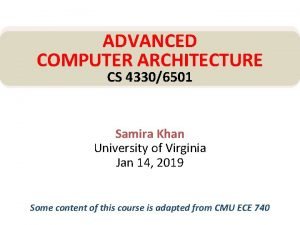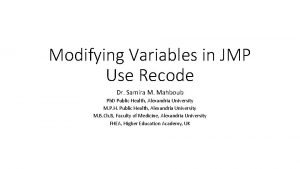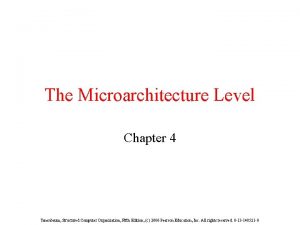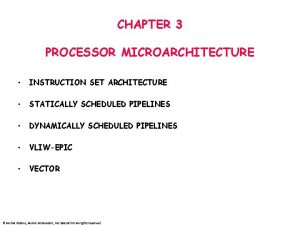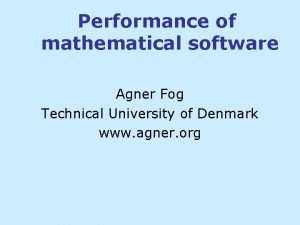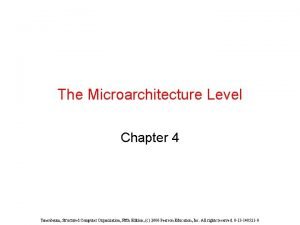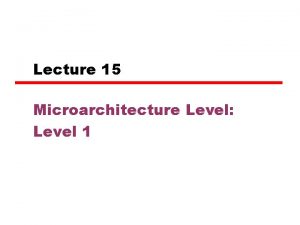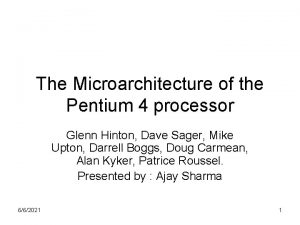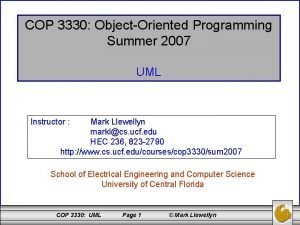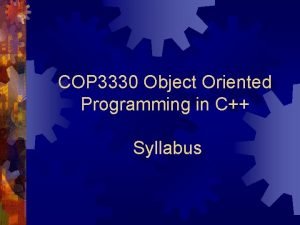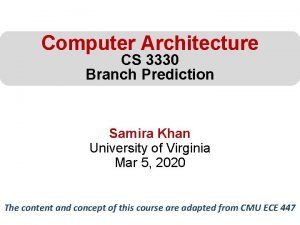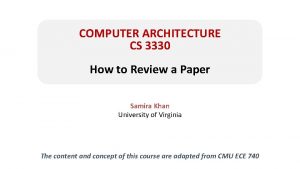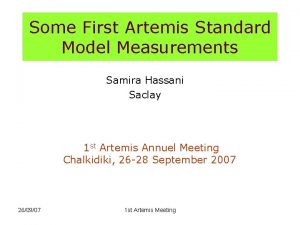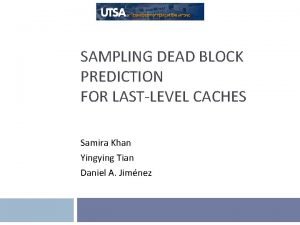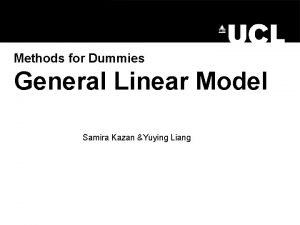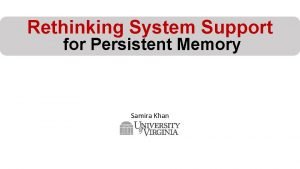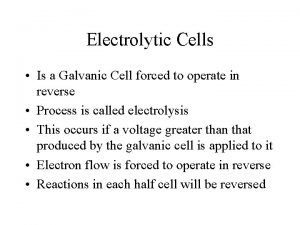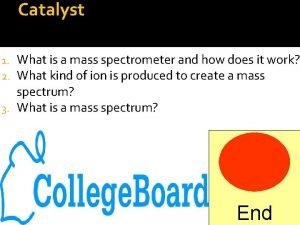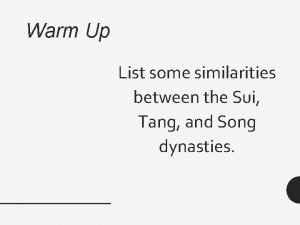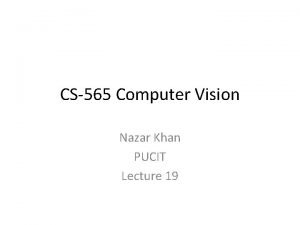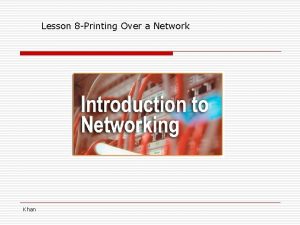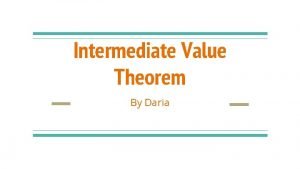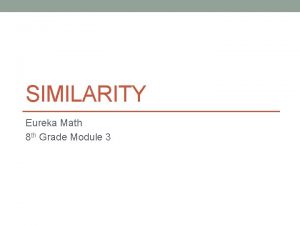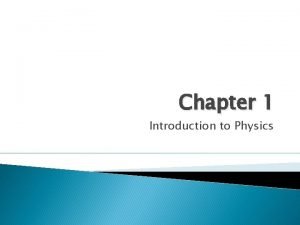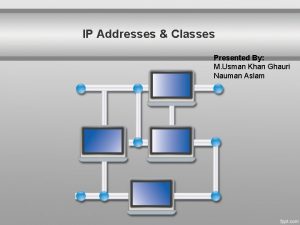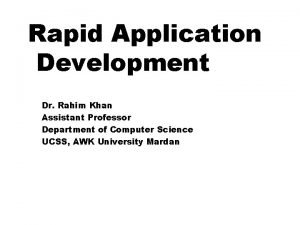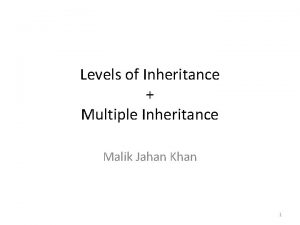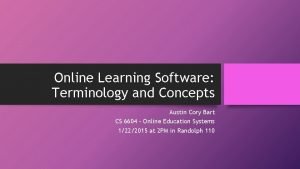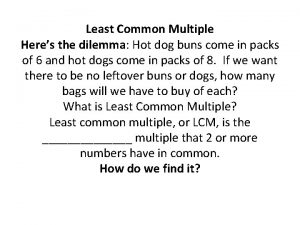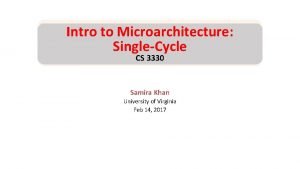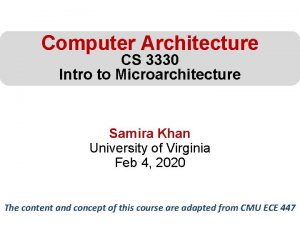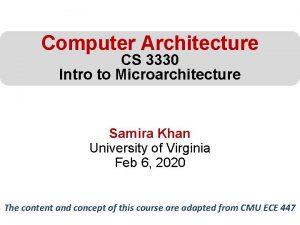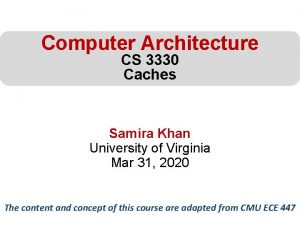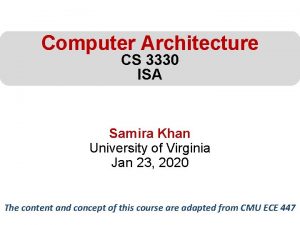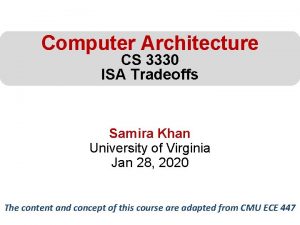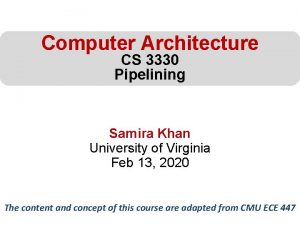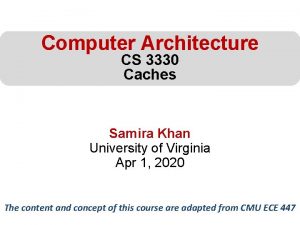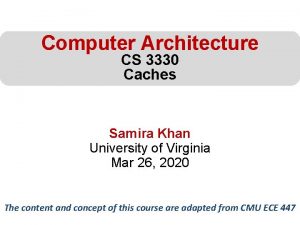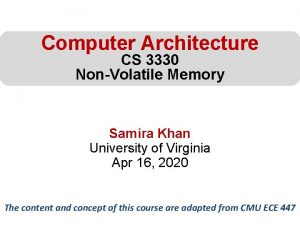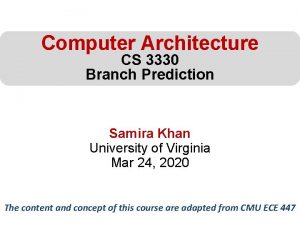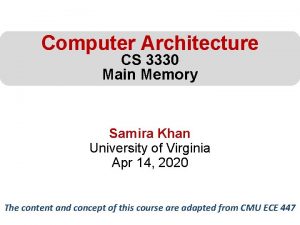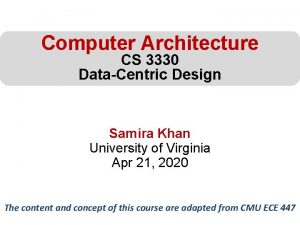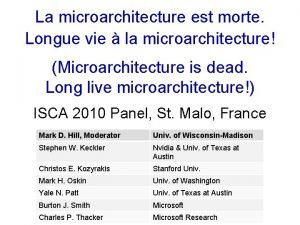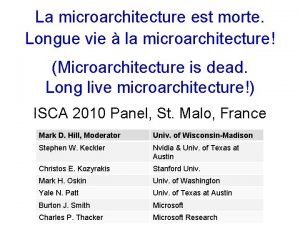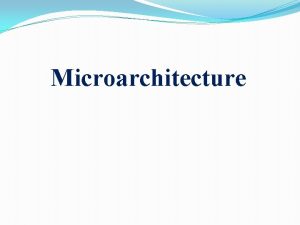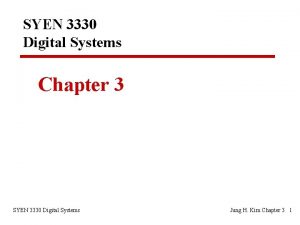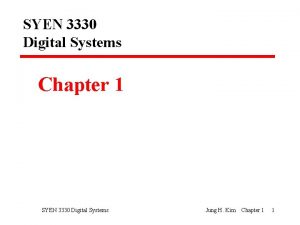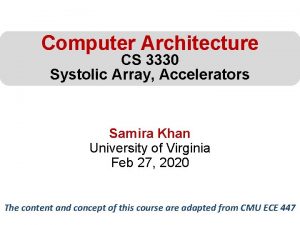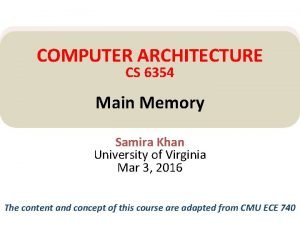Intro to Microarchitecture SingleCycle CS 3330 Samira Khan









































































![Stage Computation: immovq irmovq V, r. B Fetch icode: ifun M 1[PC] Read instruction Stage Computation: immovq irmovq V, r. B Fetch icode: ifun M 1[PC] Read instruction](https://slidetodoc.com/presentation_image_h2/624d43f6ad99701aad1b50005a80fe56/image-74.jpg)









![Stage Computation: rrmovq r. A, r. B Fetch icode: ifun M 1[PC] Read instruction Stage Computation: rrmovq r. A, r. B Fetch icode: ifun M 1[PC] Read instruction](https://slidetodoc.com/presentation_image_h2/624d43f6ad99701aad1b50005a80fe56/image-84.jpg)






- Slides: 90

Intro to Microarchitecture: Single-Cycle CS 3330 Samira Khan University of Virginia Feb 9, 2017

AGENDA • Review from last lecture • ISA tradeoffs • Single-cycle Microarchitecture 2

Review: ISA vs. Microarchitecture • ISA (Instruction Set Architecture) • Agreed upon interface between software and hardware • SW/compiler assumes, HW promises • What the software writer needs to know to write and debug system/user programs • Microarchitecture • Specific implementation of an ISA • Not visible to the software • Microprocessor • ISA, uarch, circuits • “Architecture” = ISA + microarchitecture Problem Algorithm Program ISA Microarchitecture Circuits Transistors 3

Review: ISA • Instructions • Opcodes, Addressing Modes, Data Types • Instruction Types and Formats • Registers, Condition Codes • Memory • Address space, Addressability, Alignment • Virtual memory management • Call, Interrupt/Exception Handling • Access Control, Priority/Privilege • I/O: memory-mapped vs. instr. • Task/thread Management • Power and Thermal Management • Multi-threading support, Multiprocessor support 4

Microarchitecture • Implementation of the ISA under specific design constraints and goals • Anything done in hardware without exposure to software • • • Pipelining (will see later) Clock gating Caching? Levels, size, associativity, replacement policy Prefetching? Voltage/frequency scaling? Error correction? 5

Property of ISA vs. Uarch? • ADD instruction’s opcode • Number of general purpose registers • Number of ports to the register file • Number of cycles to execute the MUL instruction • Whether or not the machine employs pipelined instruction execution • Remember • Microarchitecture: Implementation of the ISA under specific design constraints and goals 6

Design Point • A set of design considerations and their importance • leads to tradeoffs in both ISA and uarch • Considerations • • Cost Performance Maximum power consumption Energy consumption (battery life) Availability Reliability and Correctness Time to Market • Design point determined by the “Problem” space (application space), the intended users/market 7

Design Point • A set of design considerations and their importance • leads to tradeoffs in both ISA and uarch • Considerations • • Cost Performance Maximum power consumption Energy consumption (battery life) Availability Reliability and Correctness Time to Market • Design point determined by the “Problem” space (application space), the intended users/market Look Forward & Up 8

ROLE OF THE (COMPUTER) ARCHITECT from Yale Patt’s lecture notes 9

ROLE OF THE (COMPUTER) ARCHITECT • Look backward (to the past) • Understand tradeoffs and designs, upsides/downsides, past workloads. Analyze and evaluate the past • Look forward (to the future) • Be the dreamer and create new designs. Listen to dreamers • Push the state of the art. Evaluate new design choices • Look up (towards problems in the computing stack) • Understand important problems and their nature • Develop architectures and ideas to solve important problems • Look down (towards device/circuit technology) • Understand the capabilities of the underlying technology • Predict and adapt to the future of technology (you are designing for N years ahead). Enable the future technology 10

Application Space • Dream, and they will appear… 11

Tradeoffs: Soul of Computer Architecture • ISA-level tradeoffs • Microarchitecture-level tradeoffs • System and Task-level tradeoffs • How to divide the labor between hardware and software • Computer architecture is the science and art of making the appropriate trade-offs to meet a design point • Why art? 12

ISA Principles and Tradeoffs

Many Different ISAs Over Decades • • • x 86 PDP-x: Programmed Data Processor (PDP-11) VAX IBM 360 CDC 6600 SIMD ISAs: CRAY-1, Connection Machine VLIW ISAs: Multiflow, Cydrome, IA-64 (EPIC) Power. PC, POWER RISC ISAs: Alpha, MIPS, SPARC, ARM • What are the fundamental differences? • E. g. , how instructions are specified and what they do • E. g. , how complex are the instructions 14

MIPS 0 rs rt rd opcode rs rt immediate opcode immediate 6 -bit 5 -bit 26 -bit 5 -bit 16 -bit shamt 5 -bit funct 6 -bit R-type I-type J-type 15

ARM 16

What Are the Elements of An ISA? • Instructions • Opcode • Operand specifiers (addressing modes) • How to obtain the operand? Why are there different addressing modes? • Data types • Definition: Representation of information for which there are instructions that operate on the representation • Integer, floating point, character, binary, decimal, BCD • Doubly linked list, queue, string, bit vector, stack • VAX: INSQUEUE and REMQUEUE instructions on a doubly linked list or queue; FINDFIRST • Digital Equipment Corp. , “VAX 11 780 Architecture Handbook, ” 1977. • X 86: SCAN opcode operates on character strings; PUSH/POP 17

Data Type Tradeoffs • What is the benefit of having more or high-level data types in the ISA? • What is the disadvantage? • Think compiler/programmer vs. microarchitect • Concept of semantic gap • Data types coupled tightly to the semantic level, or complexity of instructions • Example: Early RISC architectures vs. Intel 432 • Early RISC: Only integer data type • Intel 432: Object data type, capability based machine 18

Complex vs. Simple Instructions • Complex instruction: An instruction does a lot of work, e. g. many operations • Insert in a doubly linked list • Compute FFT • String copy • Simple instruction: An instruction does small amount of work, it is a primitive using which complex operations can be built • Add • XOR • Multiply 19

Complex vs. Simple Instructions • Advantages of Complex instructions + Denser encoding smaller code size better memory utilization, saves off-chip bandwidth, better cache hit rate (better packing of instructions) + Simpler compiler: no need to optimize small instructions as much • Disadvantages of Complex Instructions - Larger chunks of work compiler has less opportunity to optimize (limited in fine-grained optimizations it can do) - More complex hardware translation from a high level to control signals and optimization needs to be done by hardware 20

ISA-level Tradeoffs: Semantic Gap • Where to place the ISA? Semantic gap • Closer to high-level language (HLL) Small semantic gap, complex instructions • Closer to hardware control signals? Large semantic gap, simple instructions • RISC vs. CISC machines • RISC: Reduced instruction set computer • CISC: Complex instruction set computer • FFT, QUICKSORT, POLY, FP instructions? • VAX INDEX instruction (array access with bounds checking) 21

ISA-level Tradeoffs: Semantic Gap • Some tradeoffs (for you to think about) • Simple compiler, complex hardware vs. complex compiler, simple hardware • Burden of backward compatibility • Performance? Energy Consumption? • Optimization opportunity: Example of VAX INDEX instruction: who (compiler vs. hardware) puts more effort into optimization? • Instruction size, code size 22

Small versus Large Semantic Gap • CISC vs. RISC • Complex instruction set computer complex instructions • Initially motivated by “not good enough” code generation • Reduced instruction set computer simple instructions • John Cocke, mid 1970 s, IBM 801 • Goal: enable better compiler control and optimization • RISC motivated by • Memory stalls (no work done in a complex instruction when there is a memory stall? ) • When is this correct? • Simplifying the hardware lower cost, higher frequency • Enabling the compiler to optimize the code better • Find fine-grained parallelism to reduce stalls 23

ISA-level Tradeoffs: Instruction Length • Fixed length: Length of all instructions the same + Easier to decode single instruction in hardware + Easier to decode multiple instructions concurrently -- Wasted bits in instructions (Why is this bad? ) -- Harder-to-extend ISA (how to add new instructions? ) • Variable length: Length of instructions different (determined by opcode and sub-opcode) + Compact encoding (Why is this good? ) Intel 432: 6 to 321 bit instructions. -- More logic to decode a single instruction -- Harder to decode multiple instructions concurrently • Tradeoffs • Code size (memory space, bandwidth, latency) vs. hardware complexity • ISA extensibility and expressiveness vs. hardware complexity • Performance? Energy? Smaller code vs. ease of decode 24

ISA-level Tradeoffs: Uniform Decode • Uniform decode: Same bits in each instruction correspond to the same meaning • Opcode is always in the same location • Ditto operand specifiers, immediate values, … • Many “RISC” ISAs: Alpha, MIPS, SPARC + Easier decode, simpler hardware + Enables parallelism: generate target address before knowing the instruction is a branch -- Restricts instruction format (fewer instructions? ) or wastes space • Non-uniform decode • E. g. , opcode can be the 1 st-7 th byte in x 86 + More compact and powerful instruction format -- More complex decode logic 25

ISA-level Tradeoffs: Number of Registers • Affects: • Number of bits used for encoding register address • Number of values kept in fast storage (register file) • (uarch) Size, access time, power consumption of register file • Large number of registers: + Enables better register allocation (and optimizations) by compiler fewer saves/restores -- Larger instruction size -- Larger register file size 26

ISA-level Tradeoffs: Addressing Modes • Addressing mode specifies how to obtain an operand of an instruction • Register • Immediate • Memory (displacement, register indirect, indexed, absolute, memory indirect, autoincrement, autodecrement, …) • More modes: + help better support programming constructs (arrays, pointerbased accesses) -- make it harder for the architect to design -- too many choices for the compiler? • Many ways to do the same thing complicates compiler design • Wulf, “Compilers and Computer Architecture, ” IEEE Computer 1981 27

A Note on RISC vs. CISC • Usually, … • RISC • • Simple instructions Fixed length Uniform decode Few addressing modes • CISC • • Complex instructions Variable length Non-uniform decode Many addressing modes 28

Food for Thought for You • How would you design a new ISA? • Where would you place it? • What design choices would you make in terms of ISA properties? • What would be the first question you ask in this process? • “What is my design point? ” Look Forward & Up 29

Y 86 -64 Instruction Set #1 Byte 0 halt 0 0 nop 1 0 cmov. XX r. A, r. B 2 fn r. A r. B irmovq V, r. B 3 0 F rmmovq r. A, D(r. B) 4 0 r. A r. B D mrmovq D(r. B), r. A 5 0 r. A r. B D OPq r. A, r. B 6 fn r. A r. B j. XX Dest 7 fn Dest call Dest 8 0 ret 9 0 pushq r. A A 0 r. A F popq r. A B 0 r. A F 1 2 3 4 5 6 7 8 9 r. B V Dest 30

Now That We Have an ISA • How do we implement it? • i. e. , how do we design a system that obeys the hardware/software interface? 31

Implementing the ISA: Microarchitecture Basics

How Does a Machine Process Instructions? • What does processing an instruction mean? • Remember the von Neumann model AS = Architectural (programmer visible) state before an instruction is processed Process instruction AS’ = Architectural (programmer visible) state after an instruction is processed • Processing an instruction: Transforming AS to AS’ according to the ISA specification of the instruction 33

The “Process instruction” Step • ISA specifies abstractly what AS’ should be, given an instruction and AS • It defines an abstract finite state machine where • State = programmer-visible state • Next-state logic = instruction execution specification • From ISA point of view, there are no “intermediate states” between AS and AS’ during instruction execution • One state transition per instruction • Microarchitecture implements how AS is transformed to AS’ • There are many choices in implementation • We can have programmer-invisible state to optimize the speed of instruction execution: multiple state transitions per instruction • Choice 1: AS AS’ (transform AS to AS’ in a single clock cycle) • Choice 2: AS AS+MS 1 AS+MS 2 AS+MS 3 AS’ (take multiple clock cycles to transform AS to AS’) 34

A Very Basic Instruction Processing Engine • Each instruction takes a single clock cycle to execute • Only combinational logic is used to implement instruction execution • No intermediate, programmer-invisible state updates AS = Architectural (programmer visible) state at the beginning of a clock cycle Process instruction in one clock cycle AS’ = Architectural (programmer visible) state at the end of a clock cycle 35

A Very Basic Instruction Processing Engine • Single-cycle machine Combinational Logic AS’ (State) AS • What is the clock cycle time determined by? • What is the critical path of the combinational logic determined by? 36

Assembly/Machine Code View CPU Registers PC Condition Codes Addresses Data Instructions Memory Code Data Stack Programmer-Visible State • PC: Program counter • Address of next instruction • Called “RIP” (x 86 -64) • Register file • Heavily used program data • Condition codes • Memory • Byte addressable array • Code and user data • Stack to support procedures • Store status information about most recent arithmetic or logical operation • Used for conditional branching Instructions (and programs) specify how to transform the values of programmer visible state 37

Single-cycle vs. Multi-cycle Machines • Single-cycle machines • Each instruction takes a single clock cycle • All state updates made at the end of an instruction’s execution • Big disadvantage: The slowest instruction determines cycle time long clock cycle time • Multi-cycle machines • • n Instruction processing broken into multiple cycles/stages State updates can be made during an instruction’s execution Architectural state updates made only at the end of an instruction’s execution Advantage over single-cycle: The slowest “stage” determines cycle time Both single-cycle and multi-cycle machines literally follow the von Neumann model at the microarchitecture level 38

Instruction Processing “Stage” • Instructions are processed under the direction of a “control unit” step by step. • Instruction stage: Sequence of steps to process an instruction • Fundamentally, there are five phases: • • • Fetch Decode Evaluate Address/Fetch Operands Execute Store Result • Not all instructions require all stages 39

Instruction Processing “Cycle” vs. Machine Clock Cycle • Single-cycle machine: • All phases of the instruction processing cycle take a single machine clock cycle to complete • Multi-cycle machine: • All six phases of the instruction processing cycle can take multiple machine clock cycles to complete • In fact, each phase can take multiple clock cycles to complete 40

Instruction Processing Viewed Another Way • Instructions transform Data (AS) to Data’ (AS’) • This transformation is done by functional units • Units that “operate” on data • These units need to be told what to do to the data • An instruction processing engine consists of two components • Datapath: Consists of hardware elements that deal with and transform data signals • functional units that operate on data • hardware structures (e. g. wires and muxes) that enable the flow of data into the functional units and registers • storage units that store data (e. g. , registers) • Control logic: Consists of hardware elements that determine control signals, i. e. , signals that specify what the datapath elements should do to the data 41

Single-cycle vs. Multi-cycle: Control & Data • Single-cycle machine: • Control signals are generated in the same clock cycle as the one during which data signals are operated on • Everything related to an instruction happens in one clock cycle (serialized processing) • Multi-cycle machine: • Control signals needed in the next cycle can be generated in the current cycle • Latency of control processing can be overlapped with latency of datapath operation (more parallelism) 42

Many Ways of Datapath and Control Design • There are many ways of designing the data path and control logic • Single-cycle, multi-cycle, pipelined datapath and control • Hardwired/combinational vs. microcoded/microprogrammed control • Control signals generated by combinational logic versus • Control signals stored in a memory structure 43

Flash-Forward: Performance Analysis • Execution time of an instruction • {CPI} x {clock cycle time} • Execution time of a program • Sum over all instructions [{CPI} x {clock cycle time}] • {# of instructions} x {Average CPI} x {clock cycle time} • Single cycle microarchitecture performance • CPI = 1 • Clock cycle time = long • Multi-cycle microarchitecture performance • CPI = different for each instruction • Average CPI hopefully small • Clock cycle time = short Now, we have two degrees of freedom to optimize independently 44

A Single-Cycle Microarchitecture A Closer Look

Remember… • Single-cycle machine Combinational Logic AS’ (State) AS 46

Let’s Start with the State Elements Reg Write • Data and control inputs val. A src. A PC A Register file val. B src. B 0 val. W MUX W dst. W 1 B MUX Select Mem Write Instr Address Instruction Mem Write Data Mem Operation Read Data A B A L U 47

For Now, We Will Assume • “Magic” memory and register file • Synchronous write • the selected register is updated on the positive edge clock transition when write enable is asserted • Cannot affect read output in between clock edges 48

Instruction Processing • 6 (5) generic steps • • • Instruction fetch (IF) Instruction decode and register operand fetch (ID/RF) Execute/Evaluate memory address (EX/AG) Memory operand fetch (MEM) Store/writeback result (WB) PC Update IF EX/AG ID/RF r. B new PC P C Instr Addr Instruction Mem r. A Dest. E Val. E val. B Val. A Register file A L U MEM Read Data Address Write Data WB Data Mem 49

Instruction Processing • 6 (5) generic steps • • • Instruction fetch (IF) Instruction decode and register operand fetch (ID/RF) Execute/Evaluate memory address (EX/AG) Memory operand fetch (MEM) Store/writeback result (WB) PC Update IF r. B new PC P C EX/AG ID/RF Instr Addr Instruction Mem r. A Dest. E Val. E val. B Val. A Register file A L U MEM Read Data Address Write Data WB Data Mem 50

Instruction Processing • 6 (5) generic steps • • • Instruction fetch (IF) Instruction decode and register operand fetch (ID/RF) Execute/Evaluate memory address (EX/AG) Memory operand fetch (MEM) Store/writeback result (WB) PC Update IF r. B new PC P C EX/AG ID/RF Instr Addr Instruction Mem r. A Dest. E Val. E val. B Val. A Register file A L U MEM Read Data Address Write Data WB Data Mem 51

Instruction Processing • 6 (5) generic steps • • • Instruction fetch (IF) Instruction decode and register operand fetch (ID/RF) Execute/Evaluate memory address (EX/AG) Memory operand fetch (MEM) Store/writeback result (WB) PC Update IF r. B new PC P C EX/AG ID/RF Instr Addr Instruction Mem r. A Dest. E Val. E val. B Val. A Register file A L U MEM Read Data Address Write Data WB Data Mem 52

Single-Cycle Datapath for Arithmetic and Logical Instructions

Executing Arith. /Logical Operation OPq r. A, r. B • Fetch • Read 2 bytes • Decode • Read operand registers • Execute • Perform operation • Set condition codes 6 fn r. A r. B • Memory • Do nothing • Write back • Update register • PC Update • Increment PC by 2 54

Stage Computation: Arith/Log. Ops Fetch Decode Execute Memory Write OPq r. A, r. B icode: ifun M 1[PC] r. A: r. B M 1[PC+1] val. P PC+2 val. A R[r. A] val. B R[r. B] val. E val. B OP val. A Set CC R[r. B] val. E back PC update PC val. P Read instruction byte Read register byte Compute next PC Read operand A Read operand B Perform ALU operation Set condition code register Write back result Update PC • Formulate instruction execution as sequence of simple steps • Use same general form for all instructions 55

ALU Datapath Reg Write r. A P C Instr Addr Instruction Mem 2 r. B Dest. E Val. E val. A Val. B ALU OP A L U Read Data Address Register file Write Data Mem EX MEM WB A DD if MEM[PC] == OPq r. A, r. B R[r. B] op R[r. A] PC + 2 **Based on original figure from [P&H CO&D, COPYRIGHT 2004 Elsevier. ALL RIGHTS RESERVED. ] IF ID PC Combinational state update logic 56

ALU Datapath Reg Write r. A P C Instr Addr Instruction Mem 2 r. B Dest. E Val. E val. A Val. B ALU OP A L U Read Data Address Register file Write Data Mem EX MEM WB A DD if MEM[PC] == OPq r. A, r. B R[r. B] op R[r. A] PC + 2 **Based on original figure from [P&H CO&D, COPYRIGHT 2004 Elsevier. ALL RIGHTS RESERVED. ] IF ID PC Combinational state update logic 57

We did not cover these slides in the class Will learn about these in the next class They are here for your benefit

Single-Cycle Datapath for Data Movement Instructions

Executing mrmovq (Load from Mem to Reg) mrmovq D(r. B) , r. A 6 fn r. A r. B D • Fetch • Memory • Read 10 bytes • Read from memory • Decode • Write back • Read operand registers • Write to Register • Execute • PC Update • Compute effective • Increment PC by 10 address 60

Stage Computation: mrmovq D(r. B), r. A Fetch Decode Execute Memory Write back PC update icode: ifun M 1[PC] Read instruction byte r. A: r. B M 1[PC+1] Read register byte val. C M 8[PC+2] Read displacement D val. P PC+10 Compute next PC val. B R[r. B] Read operand B val. E val. B + val. C Compute effective address val. M M 8[val. E] Write value to memory R[r. A] val. M PC val. P Update PC • Use ALU for address computation 61

Ld Datapath Reg Write val. B r. B P C Instr Addr Instruction Mem r. B M U r. A X r. A Dest. E Val. E ALU OP A L U M U X Val. A Register file Read Data Address Write Data Mem MEM WB PC D 10 A DD if MEM[PC]== mrmovq Disp (r. B), r. A EA = Disp + R[r. B] R[r. A] MEM[EA] PC + 10 M U X From ALU From Mem MUX Select IF ID EX Combinational state update logic 62

Ld Datapath Reg Write val. B r. B P C Instr Addr Instruction Mem r. B M U r. A X r. A Dest. E Val. E ALU OP A L U M U X Val. A Register file Read Data Address Write Data Mem MEM WB PC D 10 A DD if MEM[PC]== mrmovq Disp (r. B), r. A EA = Disp + R[r. B] R[r. A] MEM[EA] PC + 10 M U X From ALU From Mem MUX Select IF ID EX Combinational state update logic 63

Ld Datapath Reg Write val. B r. B P C Instr Addr Instruction Mem r. B M U r. A X r. A Dest. E Val. E ALU OP A L U M U X Val. A Register file Read Data Address Write Data Mem MEM WB PC D 10 A DD if MEM[PC]== mrmovq Disp (r. B), r. A EA = Disp + R[r. B] R[r. A] MEM[EA] PC + 10 M U X From ALU From Mem MUX Select IF ID EX Combinational state update logic 64

Ld Datapath Reg Write val. B r. B P C Instr Addr Instruction Mem r. B M U r. A X r. A Dest. E Val. E ALU OP A L U M U X Val. A Register file Read Data Address Write Data Mem MEM WB PC D 10 A DD if MEM[PC]== mrmovq Disp (r. B), r. A EA = Disp + R[r. B] R[r. A] MEM[EA] PC + 10 M U X From ALU From Mem MUX Select IF ID EX Combinational state update logic 65

Ld Datapath Reg Write val. B r. B P C Instr Addr Instruction Mem r. B M U r. A X r. A Dest. E Val. E ALU OP A L U M U X Val. A Register file Read Data Address Write Data Mem MEM WB PC D 10 A DD if MEM[PC]== mrmovq Disp (r. B), r. A EA = Disp + R[r. B] R[r. A] MEM[EA] PC + 10 M U X From ALU From Mem MUX Select IF ID EX Combinational state update logic 66

Executing rmmovq (St from reg to Memory) rmmovq r. A, D(r. B) 4 0 r. A r. B D • Fetch • Memory • Read 10 bytes • Write to memory • Decode • Write back • Read operand registers • Do nothing • Execute • PC Update • Compute effective address • Increment PC by 10 67

Stage Computation: rmmovq r. A, D(r. B) Fetch Decode Execute Memory Write back PC update icode: ifun M 1[PC] Read instruction byte r. A: r. B M 1[PC+1] Read register byte val. C M 8[PC+2] Read displacement D val. P PC+10 Compute next PC val. A R[r. A] Read operand A val. B R[r. B] Read operand B val. E val. B + val. C Compute effective address M 8[val. E] val. A Write value to memory PC val. P Update PC • Use ALU for address computation 68

St Datapath Reg Write P C Instr Addr Instruction Mem r. B M U r. A X r. A Dest. E Val. E ALU OP val. B r. B Mem Write A L U M U X Val. A Register file Read Data Address Write Data Mem MEM WB PC D 10 A DD if MEM[PC]== rmmovq r. A, Disp (r. B) EA = Disp + R[r. B] MEM[EA] R[r. A] PC + 10 M U X From ALU From Mem MUX Select IF ID EX Combinational state update logic 69

St Datapath Reg Write P C Instr Addr Instruction Mem r. B M U r. A X r. A Dest. E Val. E ALU OP val. B r. B Mem Write A L U M U X Val. A Register file Read Data Address Write Data Mem MEM WB PC D 10 A DD if MEM[PC]== rnmovq r. A, Disp (r. B) EA = Disp + R[r. B] MEM[EA] R[r. A] PC + 10 M U X From ALU From Mem MUX Select IF ID EX Combinational state update logic 70

St Datapath Reg Write P C Instr Addr Instruction Mem r. B M U r. A X r. A Dest. E Val. E ALU OP val. B r. B Mem Write A L U M U X Val. A Register file Read Data Address Write Data Mem MEM WB PC D 10 A DD if MEM[PC]== rnmovq r. A, Disp (r. B) EA = Disp + R[r. B] MEM[EA] R[r. A] PC + 10 M U X From ALU From Mem MUX Select IF ID EX Combinational state update logic 71

St Datapath Reg Write P C Instr Addr Instruction Mem r. B M U r. A X r. A Dest. E Val. E ALU OP val. B r. B Mem Write A L U M U X Val. A Register file Read Data Address Write Data Mem MEM WB PC D 10 A DD if MEM[PC]== rnmovq r. A, Disp (r. B) EA = Disp + R[r. B] MEM[EA] R[r. A] PC + 10 M U X From ALU From Mem MUX Select IF ID EX Combinational state update logic 72

Executing irmovq (Move imm to Reg) irmovq V, r. B 3 0 F r. B V • Fetch • Read 10 bytes • Decode • Read operand registers • Execute • Add 0 to V • Memory • Do nothing • Write back • Write V to r. B • PC Update • Increment PC by 10 73
![Stage Computation immovq irmovq V r B Fetch icode ifun M 1PC Read instruction Stage Computation: immovq irmovq V, r. B Fetch icode: ifun M 1[PC] Read instruction](https://slidetodoc.com/presentation_image_h2/624d43f6ad99701aad1b50005a80fe56/image-74.jpg)
Stage Computation: immovq irmovq V, r. B Fetch icode: ifun M 1[PC] Read instruction byte r. A: r. B M 1[PC+1] Read register byte val. C M 8[PC+2] Read displacement D val. P PC+10 Compute next PC val. E 0 + val. C Compute effective address R[r. B] val. A Write value to memory PC val. P Update PC Decode Execute Memory Write back PC update • Use ALU for address computation 74

IRMov Datapath: Option 1 Reg Write val. B r. B P C Instr Addr Instruction Mem r. B M U r. A X r. A Dest. E Val. E M ALU U OP X 0 M U X Val. A Register file Mem Write A L U Read Data Address Write Data Mem MEM WB PC D 10 A DD if MEM[PC]== irmovq V, r. B R[r. B] V PC + 10 M U X MUX Select From ALU From Mem IF ID EX Combinational state update logic 75

IRMov Datapath: Option 1 Reg Write val. B r. B P C Instr Addr Instruction Mem r. B M U r. A X r. A Dest. E Val. E M ALU U OP X 0 M U X Val. A Register file Mem Write A L U Read Data Address Write Data Mem MEM WB PC D 10 A DD if MEM[PC]== irmovq V, r. B R[r. B] V + 0 PC + 10 M U X MUX Select From ALU From Mem IF ID EX Combinational state update logic 76

IRMov Datapath: Option 1 Reg Write val. B r. B P C Instr Addr Instruction Mem r. B M U r. A X r. A Dest. E Val. E M ALU U OP X 0 M U X Val. A Register file Mem Write A L U Read Data Address Write Data Mem MEM WB PC D 10 A DD if MEM[PC]== irmovq V, r. B R[r. B] V + 0 PC + 10 M U X MUX Select From ALU From Mem IF ID EX Combinational state update logic 77

IRMov Datapath: Option 1 Reg Write val. B r. B P C Instr Addr Instruction Mem r. B M U r. A X r. A Dest. E Val. E M ALU U OP X 0 M U X Val. A Register file Mem Write A L U Read Data Address Write Data Mem MEM WB PC D 10 A DD if MEM[PC]== irmovq V, r. B R[r. B] V + 0 PC + 10 M U X MUX Select From ALU From Mem IF ID EX Combinational state update logic 78

IRMov Datapath: Option 1 Reg Write val. B r. B P C Instr Addr Instruction Mem r. B M U r. A X r. A Dest. E Val. E M ALU U OP X 0 M U X Val. A Register file Mem Write A L U Read Data Address Write Data Mem MEM WB PC D 10 A DD if MEM[PC]== irmovq V, r. B R[r. B] V + 0 PC + 10 M U X MUX Select From ALU From Mem IF ID EX Combinational state update logic 79

IRMov Datapath: Option 2 Reg Write P C Instr Addr Instruction Mem r. B M U r. A X r. A Dest. E Val. E ALU OP val. B r. B Mem Write A L U M U X Val. A Register file Read Data Address Write Data Mem MEM WB PC D 10 A DD if MEM[PC]== irmovq V, r. B R[r. B] V PC + 10 M U X MUX Select From ALU From Mem IF ID EX Combinational state update logic 80

IRMov Datapath: Option 2 Reg Write P C Instr Addr Instruction Mem r. B M U r. A X r. A Dest. E Val. E ALU OP val. B r. B Mem Write A L U M U X Val. A Register file Read Data Address Write Data Mem MEM WB PC D 10 A DD if MEM[PC]== irmovq V, r. B R[r. B] V PC + 10 M U X MUX Select From ALU From Mem IF ID EX Combinational state update logic 81

• Tradeoffs between option 1 and option 2? 82

Executing rrmovq (Move from Reg to Reg) rrmovq r. A, r. B 2 0 r. A r. B • Fetch • Read 2 bytes • Decode • Read operand register r. A • Execute • Add 0 to val r. A • Memory • Do nothing • Write back • Write val r. A to r. B • PC Update • Increment PC by 2 83
![Stage Computation rrmovq r A r B Fetch icode ifun M 1PC Read instruction Stage Computation: rrmovq r. A, r. B Fetch icode: ifun M 1[PC] Read instruction](https://slidetodoc.com/presentation_image_h2/624d43f6ad99701aad1b50005a80fe56/image-84.jpg)
Stage Computation: rrmovq r. A, r. B Fetch icode: ifun M 1[PC] Read instruction byte r. A: r. B M 1[PC+1] Read register byte Read displacement D val. P PC+2 Decode Execute Compute next PC Val. A R[r. A] val. E 0 + val. A Memory Write R[r. B] val. E back PC update PC val. P Compute effective address Write value to memory Update PC • Use ALU for address computation 84

rr. Mov Datapath: Option 1 Reg Write val. B r. B P C Instr Addr Instruction Mem r. B M U r. A X r. A Dest. E Val. E M ALU U OP X 0 M U X Val. A Register file Mem Write A L U Read Data Address Write Data Mem MEM WB PC D 2 A DD if MEM[PC]== rrmovq r. A, r. B R[r. B] R[r. A] PC + 2 M U X From ALU From Mem MUX Select IF ID EX Combinational state update logic 85

rrmov Datapath: Option 1 Reg Write val. B r. B P C Instr Addr Instruction Mem r. B M U r. A X r. A Dest. E Val. E M ALU U OP X 0 M U X Val. A Register file Mem Write A L U Read Data Address Write Data Mem MEM WB PC D 2 A DD if MEM[PC]== rrmovq r. A, r. B R[r. B] R[r. A] PC + 2 M U X From ALU From Mem MUX Select IF ID EX Combinational state update logic 86

rrmov Datapath: Option 1 Reg Write val. B r. B P C Instr Addr Instruction Mem r. B M U r. A X r. A Dest. E Val. E M ALU U OP X 0 M U X Val. A Register file Mem Write A L U Read Data Address Write Data Mem MEM WB PC D 2 A DD if MEM[PC]== rrmovq r. A, r. B R[r. B] R[r. A] PC + 2 M U X From ALU From Mem MUX Select IF ID EX Combinational state update logic 87

rrmov Datapath: Option 1 Reg Write val. B r. B P C Instr Addr Instruction Mem r. B M U r. A X r. A Dest. E Val. E M ALU U OP X 0 M U X Val. A Register file Mem Write A L U Read Data Address Write Data Mem MEM WB PC D 2 A DD if MEM[PC]== rrmovq r. A, r. B R[r. B] R[r. A] PC + 2 M U X From ALU From Mem MUX Select IF ID EX Combinational state update logic 88

rrmov Datapath: Option 2 Reg Write P C Instr Addr Instruction Mem r. B M U r. A X D 10 A DD if MEM[PC]== rrmovq r. A, r. B R[r. B] R[r. A] PC + 2 r. A Dest. E Val. E ALU OP val. B r. B Register file ? MUX Select A L U M U X Val. A M U X Mem Write Read Data Address Write Data Mem MEM WB PC From ALU From Mem IF ID EX Combinational state update logic 89

Intro to Microarchitecture: Single-Cycle CS 3330 Samira Khan University of Virginia Feb 9, 2017
 Samira khan uva
Samira khan uva Jmp recode
Jmp recode Samira khan uva
Samira khan uva Structured computer organization
Structured computer organization Instruction types
Instruction types Agner fog
Agner fog Microarchitecture diagram
Microarchitecture diagram Microarchitecture level
Microarchitecture level µops
µops Isa computer architecture
Isa computer architecture Cop 3330 ucf
Cop 3330 ucf Cop 3330 fsu
Cop 3330 fsu Cs3330
Cs3330 Cs 3330
Cs 3330 Rotary district 3330
Rotary district 3330 Samira hassani
Samira hassani Samira kazan origin
Samira kazan origin Samira zegrari
Samira zegrari Dead block 2
Dead block 2 Samira kazan
Samira kazan How to counter samira
How to counter samira Fatemeh soltani
Fatemeh soltani Downs cell
Downs cell How did kublai khan organize mongol rule in china
How did kublai khan organize mongol rule in china Monopolated light and power
Monopolated light and power Aga khan foundation tanzania
Aga khan foundation tanzania Kubla khan restaurant
Kubla khan restaurant Professor mushtaq khan
Professor mushtaq khan Bertha masons caretaker
Bertha masons caretaker Temujin last name
Temujin last name Quantum numbers khan academy
Quantum numbers khan academy Arun khan
Arun khan Learn storm
Learn storm Khan academy mass spectrometry
Khan academy mass spectrometry Khuram khan
Khuram khan Genghis khan dna map
Genghis khan dna map Akdn organizational chart
Akdn organizational chart Aga khan museum photo permit
Aga khan museum photo permit Define kublai khan
Define kublai khan Khăn trải bàn
Khăn trải bàn Wait for it...the mongols
Wait for it...the mongols Anthony russo pizza
Anthony russo pizza Nazar khan pucit
Nazar khan pucit Where did kublai khan build palaces
Where did kublai khan build palaces Electrolytic cell khan academy
Electrolytic cell khan academy Network khan
Network khan Khan academy vba
Khan academy vba Rational root theorem khan academy
Rational root theorem khan academy Amanullah khan
Amanullah khan Hakim salim khan
Hakim salim khan Khan academy active and passive voice
Khan academy active and passive voice Dr burhan khan
Dr burhan khan Genghis real name
Genghis real name Hasan irfan khan
Hasan irfan khan Kỹ thuật kipling
Kỹ thuật kipling Waseem ahmad khan
Waseem ahmad khan Grade 8 module 3
Grade 8 module 3 Humanistic psychology
Humanistic psychology Qari imran khan
Qari imran khan Short xhosa folk tales
Short xhosa folk tales Dr abdul qadeer khan contribution in physics
Dr abdul qadeer khan contribution in physics Visceral fat scale
Visceral fat scale Genghis khan mbti
Genghis khan mbti Class b 172
Class b 172 Grande odalisque
Grande odalisque Ca azfar khan salary
Ca azfar khan salary Dr rahim khan
Dr rahim khan Kubla khan setting
Kubla khan setting Kerei khan
Kerei khan Genghis khan gerbil
Genghis khan gerbil Khan academy
Khan academy Bar sauma
Bar sauma Himayatullah khan
Himayatullah khan Dr imran mehfooz
Dr imran mehfooz Kulbai khan
Kulbai khan Genghis khan academy
Genghis khan academy Jayda khan
Jayda khan Dr mohammad khan
Dr mohammad khan Picture of alliances
Picture of alliances Gail khan
Gail khan Lưu ý khi sử dụng kĩ thuật khăn trải bàn
Lưu ý khi sử dụng kĩ thuật khăn trải bàn Tehzeeb ul akhlaq
Tehzeeb ul akhlaq Malik jahan khan
Malik jahan khan Sir syed ahmed khan ideology of pakistan
Sir syed ahmed khan ideology of pakistan Sukur ali khan
Sukur ali khan Khan academy medical terminology
Khan academy medical terminology How did kublai khan organize mongol rule in china
How did kublai khan organize mongol rule in china Fraternal polyandry meaning
Fraternal polyandry meaning Genghis khan and babur
Genghis khan and babur Dr arshad ali khan
Dr arshad ali khan The hot dog buns dilemma answers
The hot dog buns dilemma answers
